Basic Civil & Mechanical Engineering: UNIT IV: g. Internal combustion engines
Two stroke cycle engines
Petrol, Diesel Engine | Cycle of operation
As the name implies, a two-stroke cycle engine performs two strokes to complete one cycle in one revolution of the crankshaft. Necessarily, two strokes out of the four strokes of a cycle are to be eliminated. The two strokes that are eliminated are suction and exhaust strokes.
TWO
STROKE CYCLE ENGINES
Description
As the name implies, a two-stroke cycle engine
performs two strokes to complete one cycle in one revolution of the crankshaft.
Necessarily, two strokes out of the four strokes of a cycle are to be
eliminated. The two strokes that are eliminated are suction and exhaust
strokes.
Suction
and exhaust strokes are combined with compression and power strokes. The power
is developed in every revolution of the crankshaft.
See
Fig. 6.
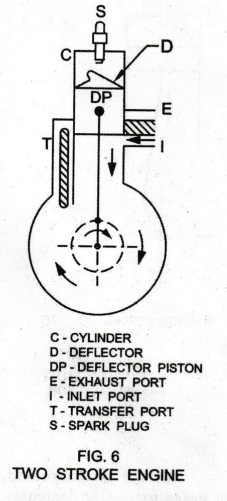
Two-stroke
engine has only ports at the cylinder walls and has no valves. In the case of
single cylinder two stroke engines (used in scooters and motorcycles), three
ports are provided, namely, inlet, transfer and exhaust.
These
ports are opened and closed by the movement of the piston itself. Note that the
exhaust port is located slightly above the transfer port.
Through
the inlet port, fresh charge from the carburetor is taken into the cylinder
crank case. Through the transfer port, the fresh charge from the bottom of the
piston is supplied to the cylinder. Through the exhaust port, the hot gases are
pushed out.
1. TWO STROKE PETROL ENGINE
Scavenging
In the two-stroke petrol engine, the exhaust
gases are removed from the cylinder with the help of fresh compressed charge.
This process of removing exhaust gases is called Scavenging. A specific shape
is given to the piston, called deflector. The deflector helps to prevent the
loss of incoming charge and helps for exhausting the hot gases effectively.
It
will be easier to describe the cycle beginning at the point when the piston
reaches TDC at the end of the compression stroke. In the two-stroke petrol
engine, the draw of petrol-air mixture into the cylinder will not take place in
a separate stroke. Therefore, the method of draw of petrol-air mixture should
be understood properly.
First Stroke
Fig. 7(a) shows the position of the piston at
the end of compression. The spark is produced by the spark plug as the piston
reaches TDC. The pressure and temperature of the gases are increased and hence
the gases push the piston downwards producing the power stroke.
Refer Fig. 7(b). When the piston opens the exhaust port during the downward stroke, burnt gases.leave the cylinder through the exhaust port.
Refer
Fig. 7(c). A little later, the piston uncovers the transfer port and the crank
case is directly connected to the cylinder through the transfer port. The
downward stroke of the piston compresses the charge in the crank case by the
underside of the piston.
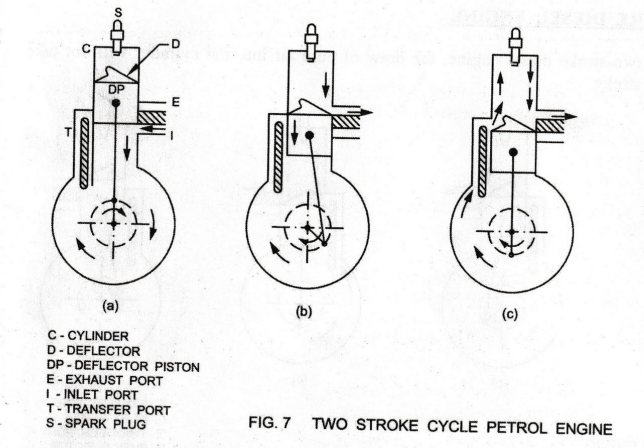
Scavenging:
In the above position of the piston, the compressed mixture of petrol and air
is transferred through the transfer port to the upper part of the cylinder. The
exhaust gases are pushed out, with the help of compressed charge. This is known
as Scavenging. Scavenging is continued until the piston reaches BDC.
Second Stroke
As
the piston moves upwards, it covers the transfer port. Hence, flow of charge
into the cylinder is stopped. The upward motion of the piston lowers the
pressure in the crank case below atmosphere and fresh air is induced in the
crank case through the inlet port as it is uncovered. A little later, the
piston covers the exhaust port and actual compression of the charge starts as
shown in Fig. 7(d).
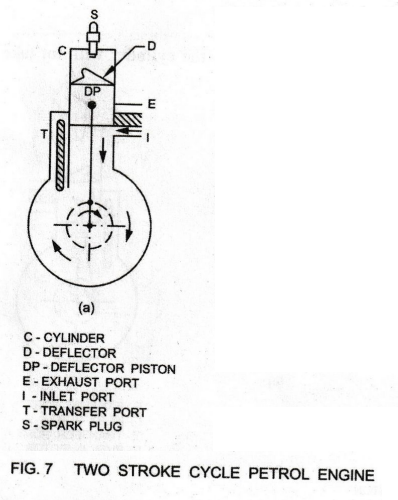
The
compression is continued until the piston reaches TDC. The ratio of compression
ranges from 1:7 to 1:10. The cycle is thus completed within two strokes.
Note: The
two-stroke engine requires only two strokes of the piston to complete one cycle
of operation. The crankshaft makes only one revolution to complete one cycle.
Power is developed in every revolution of the crankshaft.
Uses:
Two-stroke petrol engines are used in mopeds, scooters, motorcycles, because
they run at high speeds with moderate power outputs.
2. TWO STROKE DIESEL ENGINE
Refer
Fig. 8. In two-stroke diesel engine, the draw of pure air into the cylinder
will not take place in a separate stroke.
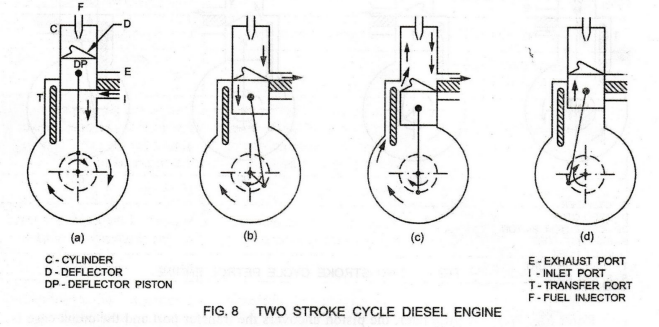
First Stroke
Fig. (a) shows the position of the piston at
the end of compression. Diesel is injected using fuel injector just before
completing the compression. It starts burning. The high pressure, high
temperature gases push the piston downwards, producing the power stroke. As the
piston moves little down, the supply of diesel stops.
Refer
Fig. (b). In this, the piston uncovers the exhaust port during the downward
stroke. Hence the burnt gases leave the cylinder through the exhaust port.
Refer
Fig. (c). A little later, the piston uncovers the transfer port as shown. Now,
the crank case is directly connected to the cylinder through the transfer port.
Air in the crank case is compressed by underside of the piston and the
compressed air is transferred to the cylinder through transfer port. The
exhaust gases are pushed out with the help of fresh air until the piston
reaches BDC (similar to two stroke petrol engine).
Second Stroke
The piston moves upwards. It first covers the
transfer port and stops the flow of air into the cylinder. A little later, the
piston covers the exhaust port as shown in Fig. (d), and actual compression of
air starts. The upward motion of the piston lowers the pressure in the crank
case below atmosphere and fresh air is induced in the crank case through the
inlet port as it is uncovered. The compression of air is continued until the
piston reaches TDC.
The
fuel supply starts just before the piston reaches TDC and the cycle is
completed.
3. COMPARISON OF FOUR STROKE AND TWO STROKE ENGINES
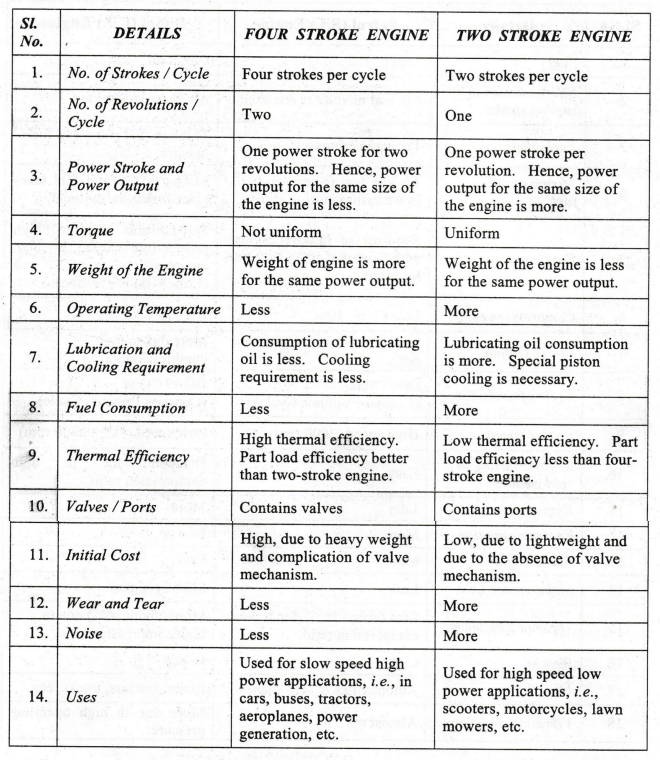
4. COMPARISON OF PETROL ENGINE AND DIESEL ENGINE
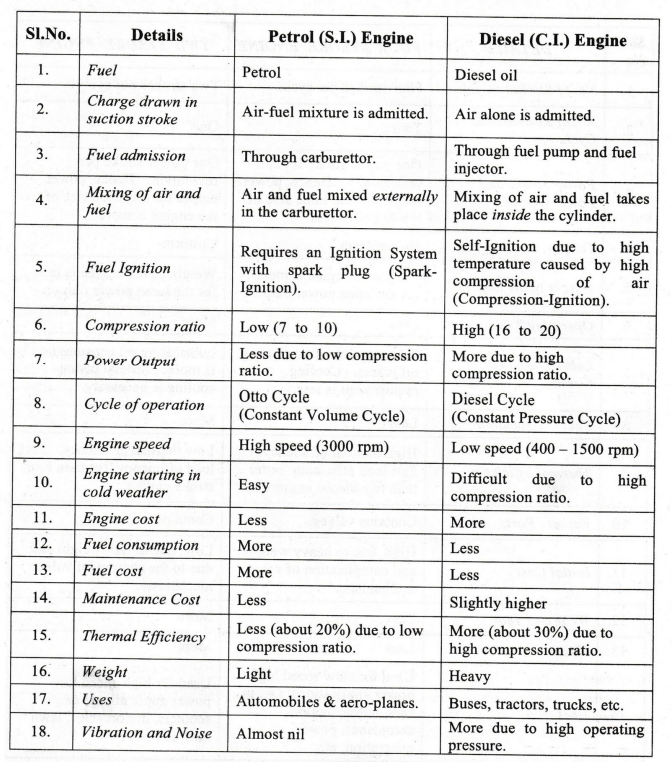
Basic Civil & Mechanical Engineering: UNIT IV: g. Internal combustion engines : Tag: : Petrol, Diesel Engine | Cycle of operation - Two stroke cycle engines
Related Topics
Related Subjects
Basic Civil and Mechanical Engineering
BE3255 2nd Semester 2021 Regulation | 2nd Semester EEE Dept 2021 Regulation
